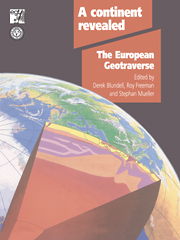1 - WHY A TRAVERSE THROUGH EUROPE?
Published online by Cambridge University Press: 05 November 2009
Summary
TECTONIC EVOLUTION OF A CONTINENT
Piecing together the geological evolution of a continent is rather like a detective investigation. Various pieces of evidence provide clues as to what might have happened, but these can be assembled in a variety of ways. Various theories, based on certain geological mechanisms, are put forward to test the evidence. Europe has a history of geological activity and continental evolution spanning over 3500 million years (Ma) to the present day and is one of the best places in the world to discover how a continent evolves. The geology of Europe has been studied intensively for well over a century by examining outcrops of rocks at the surface, so that the surface geology is probably better known than anywhere else in the world. In contrast, knowledge of what the geology is like beneath the surface is limited to information from boreholes and indirect evidence, principally from geophysical measurements.
Since the theory of plate tectonics came to prominence in the mid 1960s, a mechanism has become understood which explains how global tectonic processes take place at the present day. It is known that, on a global scale, the outer region of the Earth called the lithosphere, which includes both crust and upper mantle, acts as a more rigid layer above a more plastic layer of the upper mantle, called the asthenosphere. The lithosphere is divided into a dozen or so major plates which move relative to each other, interacting and deforming, mostly around their perimeters. Direct evidence of plate movements has been recorded in oceanic crust for the past 200 Ma but beyond that time no oceanic crust exists intact to tell the tale.
- Type
- Chapter
- Information
- A Continent RevealedThe European Geotraverse, Structure and Dynamic Evolution, pp. 1 - 10Publisher: Cambridge University PressPrint publication year: 1992
- 4
- Cited by



